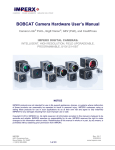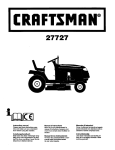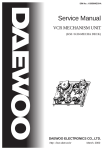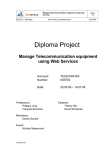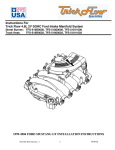Download Daewoo VCR MECHANISM UNIT Service manual
Transcript
THOMSON Brandt FERGUSON SERVICE MANUAL DOCUMENTATION TECHNIQUE TECHNISCHE DOKUMENTATION DOCUMENTAZIONE TECNICA DOCUMENTACION TECNICA M U LT I MEDIA THOMSON X1000 (DECK MECHANISM) WARNING : Before servicing this chassis please read the safety recommendations. ATTENTION : Avant toute intervention sur ce châssis, lire les recommandations de sécurité. ACHTUNG : Vor jedem Eingriff auf iesem Chassis, die Sicherheitsvorschriffen lesen. ATTENZIONE : Prima di intervenire sullo chassis, leggere le norme di sicurezza. IMPORTANTE : Antes de cualquier intervención, leer las recomendaciones de seguridad. CONTENTS 1. Description Of The Mechanism........................................................................................2 2. Assembly Diagram & Major Parts Check .........................................................................5 3. Disassembly & Replacement...........................................................................................12 4. Mechanical Adjustmen ....................................................................................................18 5. Adjustment Of Tape Transporting System ......................................................................21 6. Exploded View & Parts List ............................................................................................26 7. Parts List ..........................................................................................................................30 1 1. DESCRIPTION OF THE MECHANISM 1-1 Characteristic Of the T-Mecha Deck Mechanism 1) T-Mecha Deck follows the VHS standard. 2) T-Mecha Deck uses three motors(Drum motor, Capstan motor and L/C motor) 3) T-Mecha Deck uses L/C motor to drive Front Loading. 4) T-Mecha Deck recognizes each mode by using a 4-Bit Mode signal. This 4-Bit Mode signal is generated by the Cam Switch which is driven by the L/C Motor. 5) T-Mecha Deck is operated by 6 Modes(Eject/Initial/Review/Idle/Play, Stop,Slow/Brake/FF&Rewind). 6) T-Mecha Deck reduces the mode shifting time, that is, picture playing time by using the Full Loading System that has the Drum wrapped by the tape. 7) T-mecha Deck is seperated from the Main PCB. When assembling, it is connected by B-B Type connector. The Capstan motor and Drum output of T-mecha Deck and the Main PCB are directly connected without using cable. 1-2 Timming Chart 2 1-3 Wire Diagram & Connector pin Arrangement 3 2. ASSEMBLY DIAGRAM & MAJOR PARTS CHECK 2-1. ASSEMBLING DIAGRAM 2-1-1) DECK ASSEMBLY DIAGRAM A. UPPER VIEW 1. MAINBASE ASS'Y 2. DRUM ASS'Y 3. FE HEAD 4. S SLANT POLE ASS'Y 5. THENSION BAND ASS'Y 6. S BRAKE ASS'Y 7. S REEL TABLE 8. REEL BRKT TOTAL ASS'Y 9. IDLER PLATE TOTAL ASS'Y 10. T BRAKE ASS'Y 11. FL RACK 12 REALAY LEVER 13 CAPSTAN MOTOR 14 LC BRKT ASS'Y 15 PINCH LEVER TOTAL ASS'Y 16 CAM GEAR 4 17 AC HEAD ASS'Y 18 T SLANT POLE ASS'Y 19 HEAD CLEANER B. BOTTOM VIEW 20. L LOADING ASS'Y 21. R LOADING ASS'Y 22. CONNECT PLATE 23. REEL BELT 24. LOADING RACK 5 2-1-2) FRONT LOADING assemble diagram 6. DOOR OPENER 7. SAFETY LEVER R 8. FL BRKT R 1. FL BRKTL 2. TOP PLATE 3. SAFETY LEVER 4. LOADING LEVER AS4 5. CST HOLDER AS 6 2-2. PERIODIC MAINTENANCE AND SERVICE SCHEDULE 2-2-1) Periodic maintenance and Service Schedule A. In order to effectively maintain the excellent performance and fully utilize the features of this apparatus. and to lengthen the life of mechanism and tapes, we strongly urge”you to perform the periodic maintenance and inspection as described below. ¡ Following should be done after the substitution of parts of deck or correction of deck failure. B. Cleaning of the DRUM TOTAL ASS`Y - Slowly turnning DRUM TOTAL ASS`Y, wipe the drum surface with clean cloth soaked “ in alcohol. (Don’t connect the power when turnning the UPPER DRUM) - Don’t wipe the Head-Tip vertically with cleaning cloths. C. Tape transporting section cleaning - Clean the tape transporting section with clean cloth soaked in alcohol. D. Driving section cleaning - Clean the driving section with clean cloth soaked in alcohol. E. Everyday inspection - Perform the maintenance and inspection periodically according to the number of use. - Refer to the table 2.2.3. 2-2-2) Cleaning and Lubrication A. Cleaning of Tape Transporting section and driving section a. Cleaning of Tape Transporting section - The following parts shoule be cleaned after every 500 hours of use. • TENSION POLE • S SLANT POLE • AC HEAD/AE HEAD • S GUIDE POST • VIDEO HEAD / DRUM • T GUIDE POST • FE HEAD • T SLANT POLE • CAPSTASN SHAFT • S GUIDE ROLLER • T GUIDE ROLLER • PINCH ROLLER - Because the above part contacts with video tape, they tend to be stained with dusts “and foreign substances which can cause the bad effect on the picture and demage the tape sometimes. - After cleaning with alcoho., be sure to dry the surface of drum thoroughly before using a tape. b. Cleaning of the driving section •REEL TABLE •CAPSTAN FLYWHEEL/PULLEY •REEL PULLEY B. Lubrication •REEL GEAR POST : After the cleaning the parts with alcohol, lubricate them with one or two drops of oil.” •S/T REEL TABLE POST : After the cleaning the parts with alcohol, lubricate them with grease.” 7 2-2-3) SERVICE SCHEDULE FOR EACH PARTS Following parts should be checked according to the recommanded intervals. PERIODIC SERVICE (TIME) NAME 1000 2000 3000 4000 5000 DRUM TOTAL ASS'Y CAPSTAN MOTOR L/C BRKT TOTAL ASS'Y REEL BELT IDLER PLATE TOTAL ASS'Y REEL TABLE T BRAKE ASS'Y TENSION BAND ASS'Y PINCH LEVER TOTAL ASS'Y AC HEAD ASS'Y FE HEAD REEL GEAR TOTAL ASS'Y : Check and Replace if necessary. : Replace Note: Even though the unit is not used frequently, cleaning, lubrication and replacement of the belt should be undertaken every 2 years. 8 2-3. JIGS AND TOOLS 2-3-1) LIST OF JIGS AND TOOLS NO ITEMS MODEL FIG. NO NTSC: SP MONOSCOPE 7KHz SP COLORBAR 1KHz (EP MONOSCOPE) PAL/SCAM: SP MONOSCOPE 6KHz SP COLORBAR 1KHz (LP MONOSCOPE) REMARKS CHECKING OF THE TAPE TRANSPORTING SYSTEM 1 ALIGNMENT TAPE 2 CLEANING TAPE (DAEWOO) DHC-602V CHECKING OF THE TAPE TRANSPORTING SYSTEM 3 CASSETTE TAPE (KOKUSAI) KT-300NV KT-300RV MEASUREMENT OF REEL TORQUE 4 VHS SPINDLE HEIGHT GAUGE TSH-V4 MEASUREMENT OF REEL HEIGHT 5 TENTELO METER (TENTELO) T2-H7-UM MEASUREMENT OF THE BACK TENSION 6 FAN TYPE TENSION METER 7 DENTAL MIRROR BELOW 3KG CHECKING OF THE TAPE TRANSPORTING SYSTEM +DRIVER 8 MEASUREMENT OF THE PRESSING FORCE FOR THE PINCH ROLLER -1 HEX DRIVER -2 ADJUSTMENT DR IVER -3 9 ASSEMBLY, DISASSEMBLY AND ADJUSTMENT 2-3-2) SKETCH OF JIGS AND TOOLS CLE ANI NG TAP E TAP E 30 10 8-2 0 30 10 8-1 VHS SPINDLE HEIGHT GAUGE 0 10 10 30 20 20 20 30 ALI GN ME NT 10 8-3 20 3. DISASSEMBLY AND REPLACEMENT 3-1. Removal of the FRONT LOADING Ass’y (Fig. 3.1) 3-2. Disassembly of FRONT LOADING Ass’y (FIg. 3.2~3.5) a. Remove the washer holding the door opener and separate F/L Assembly by moving the DOOR OPENER in the direction of arrow. b. Remove the 2 screw holding the TOP PLATE and separate the CASSETTE HOLDER Ass’y by moving the FL BRKT L and FL BRKT R in the direction of arrow. (Fig. 3.2) NOTE: Remove the FRONT LOADING Ass’y in eject mode. a. Unscrew the 2 screw holding the F/L ass’y. b. Separate the F/L Ass’y from the MAINBASE ass’y by lifting the rear part of F/L (Screw Hole). FIg. 3.2 Disassembly of the FRONT LOADING Ass’y Fig. 3.1 Removal of the FRONT LOADING Ass’y 11 c. Separate the LOADING LEVER Ass’y by pressing the connection point from the CASSETTE HOLDER Ass’y. (Fig. 3.4) d. Remove the SAFETY SPRING connecting the SAFETY LEVER and CASSTTE HOLDER PLATE. (Fig. 3.3) e. Remove the RELEASE SPRING connecting the RELEASE LEVER and SAFETY LEVER. (Fig. 3.3)3- 3. Disassembly of DRUM Ass’y (Fig. 3.5) a. Turn over the DECK MECHANISM and holding the DRUM TOTAL Ass’y @ with hands, remove the 3 screw holding the drum total assembly with mainbase. b. Separate the DRUM TOTAL Ass’y from the deck paying attention there is no damage on the surface of VIDEO HEAD and DRUM. c. Assemble in the reverse order of disassembly. CAUTION: • After the assembly of the DRUM TOTAL Ass’y, check out if DECK Mechanism operate smoothly and adjustment of tape transmission section is OK. FIg. 3.3 Disassembly of the CASSETTE HOLDER Ass’y CAUTION: • Assemble the FRONT LOADING Ass’y in the reverse order of disassembly. • Confirm that 2 bosses on the left side of the CASSETTE HOLDER Ass’y are inserted in the groove on the left side of the top plate. Insert 2 bosses on the right side of the CASSETTE HOLDER Ass’y into the groove of the F/L BRACKET R. (Fig. 3.4) FIg. 3.5 Assembly of the DRUM TOTAL Ass’y FIg. 3.4 Assembly of the FL Ass’y 12 3-4. Disassembly of LOADING RACK, LOADING ASS’Y, S/T SLANT POLE ASS’Y (Fig. 3.6, 3.7) 3-5. Disassembly of the A/C HEAD ASS’Y (Fig. 3.8) a. Remove the CONNECTOR @ from the AC HEAD Ass’y, use caution not to damage the HEAD connector pins. b. Separate the AC HEAD Ass’y ! after removing the screw #. a. Turn the DECK MECHANISM over and remove the LOADING RACK@ after unscrewing the SCREW !. b. Remove the R LOADING AS # and L LOADING AS $. c. Remove the S SLANT POLE AS % and T SLANT POLE AS ^ by moving those part in arrow direction. CAUTION: • After the assembly, adjust the tape transmission section by refering to chapter 5. • After the adjustment of the tape transmission section, paint the 3 adjustment screw with locking paint. CAUTION: • Take care GUIDE ROLLER of S/T SLANT POLE AS and SLANT POLE not to be stained with grease during assembly. • Refer to Fig. 3.7 in assembly. FIg. 3.8 Disassembly of the AC HEAD ASS’Y FIg. 3.6 Disassembly of the LOADING RACK, LOADING ASS’Y and the SLANT POLE ASS’Y FIg. 3.7 Assembly of the L/R LOADING AS and the LOADING RACK 13 3-6. Disassembly of the LC BRKT ASS’Y, PINCH LEVER TOTAL ASS’Y (Fig. 3.9) a. Separate the LC BRKT Ass’y @ after removing 3 screws !. b. Separate the LC BRKT Ass’y @ from the DECK MECHANISM. c. Remove the PINCH LEVER TOTAL Ass’y #. CAUTION: • After the assembly of the PINCH LEVER TOTAL Ass’y, adjust the tape transmission section by refering to chapter 5. • Be careful not to get grease or other foreign materials on the surface of the pinch roller $. • Make sure if the end of the PINCH SPRING PINCH “A” is located at the end of the slot of CAM GEAR “B” in assembly. (Refer to Fig. 4.3) 3-7. Disassembly of the CAM GEAR, RELAY LEVER, FL RACK (Fig. 3.9) FIg. 3.10 Assembly of the CAM GEAR, RELAY LEVER a. Separate the CAM GEAR % from the MAINBASE. b. Separate the RELAY LEVER ^ from the MAINBASE. c. Separate the FL RACK & from MAINBASE by moving to the arrow direction. CAUTION: • When reassembling, refer to Fig. 3.10, Fig. 3.11 and chapter 4. FIg. 3.11 Assembly of the CAM GEAR, FL RACK FIg. 3.9 Disassembly of the LC BRACKET ASS’Y from the PINCH LEVER TOTAL ASS’Y 14 3-8. Disassembly of the S/T BRAKE ASS’Y (Fig.3.12) a. Separate the CAPSTAN MOTOR % after the removal of 3 screws $ holding the capstan motor. a. Unhook the S BRAKE SPRING # from the MAINBASE HOOK !. b. Remove the S BRAKE Ass’y @ from the mainbase. c. Remove the T BRAKE SPRING ^ from the MAINBASE HOOK $. d. Remove the T BRAKE Ass’y %. 3-11. Disassembly of the FE HEAD (Fig. 3.13) a. Remove the screw ^ and separate the FE HEAD & from the MAINBASE. FIg. 3.13 Disassembly of the TENSION BAND ASS’Y, CAPSTAN MOTOR and the FE HEAD FIg. 3.12 Disassembly of the S/T BRAKE ASS’Y 3-9. Disassembly of the TENSION BAND ASS’Y (Fig. 3.13) a. Unhook the TENSION SPRING @ from the MAINBASE HOOK !. b. Unhook the MAINBASE HOOK “A” and remove the TENSION BAND Ass’y # from the mainbase. 3-10. Disassembly of the Capstan Motor (Fig. 3.13) CAUTION: • After the assembly of TENSION BAND Ass’y on the mainbase, adjust the TENSION POLE location as shown in Fig. 3.14. • Avoid getting Grease, Oil or Foreign substance on the FELT of the BAND BRAKE. • Take care not to deform the MAINBASE HOOK “A” when separating the TENSION BAND Ass’y #. FIg. 3.14 Adjustment of the TENSION POLE POSITION 15 3-12. Disassembly of the REEL TABLE, IDLER PLATE TOTAL ASS’Y (Fig. 3.15) 3-13. Disassembly of the REEL BRKT TOTAL ASS’Y, CONNECT PLATE (Fig. 3.16) a. Remove the POLY WASHER ! and separate the IDLER PLATE TOTAL Ass’y @ from the mainbase. b. Remove the REEL TABLE $ from the REEL TABLE POST # of the MAINBASE. a. Turn over the DECK MECHANISM and remove 2 screws !. b. Remove the REEL BRKT TOTAL Ass’y @ from the MAINBASE. c. Separate the CONNECT PLATE # from the MAINBASE by pushing to the direction of the arrow. CAUTION: • Take care not to deform the IDLER PLATE TOTAL Ass’y @ when assembling and disassembling. CAUTION: • Avoid getting Grease, Oil or Foreign substance on the FELT of the Band BRAKE. • Disassembly of the IDLER Ass’y should be precede the disassembly of the REEL BRKT TOTAL Ass’y. • Check the operation of the REEL BRKT TOTAL Ass’y before assembly. • Check for smooth operation of FF/REW, PLAY, CUE and REVIEW without existence noise. FIg. 3.15 Disassembly of the REEL TABLE and the IDLER PLATE TOTAL ASS’Y FIg. 3.16 Disassembly of the REEL BRKT TOTAL ASS’Y and the CONNECT PLATE 16 4. MECHANICAL ADJUSTMENT 4-1. Mechanical Adjustment (Fig. 4.1~4.4) In case of disassembly and reassembly for fixing the mechanical problem, check the following check point. a. Make sure that the DATUM HOLE of the CAM GEAR is aligned with the DATUM HOLE in the MAINBASE in the EJECT mode as shown in Fig. 4.1. b. Make sure that the ending part “A” of the RELAY LEVER assembled on the CONNECT PLATE is aligned with the reference hole “B” of the MAINBASE as shown in Fig. 4.2. c. The end point “A” of PINCH SPRING PIN of the LEVER TOTAL Ass’y should be located within the slot “B” of the CAM GEAR. (Fig. 4.3) FIg. 4.2 Assembly reference between the RELAY LEVER and the CAM GEAR FIg. 4.1 Assembly reference between the FL RACK and the CAM GEAR FIg. 4.3 Assembly reference of the PINCH LEVER TOTAL ASS’Ywith the CAM GEAR 17 d. Make sure that the triangular mark “A” of the L LOADING Ass’y is aligned with the mark “b” of the R LOADING Ass’y. (Fig. 4.4) e. Reference hole “C” of the LOADING RACK should be aligned with the reference hole of the R LOADING Ass’y to make the teeth of the LOADING RACK is aligned as shown in Fig. 4.4. 4-2. Adjustment and measurement of the BACK TENSION (Fig. 4.5, 4.6) a. Check that the location of the TENSION POLE is in the right position. If not, adjust that by refering to the “4. Adjustment of the position of the TENSION POLE”. b. Playback a completely rewound T120 tape for 20 seconds. (Generally tape transporting section is settled down in 20 seconds) c. Measure the BACK TENSION by using the TENTELO METER. (Refer to Fig. 4.5) The result should be within the range of 20g~30g. d. If the BACK TENSION is out of the range, change the position of the TENSION SPRING of repeat the process of “4. Adjustment of the position of the TENSION POLE”. (Fig. 4.6) CAUTION: • If the measurement result is greater than the upper limit, change the hook point of the spring to position “A”. • Confirm that all of the three probes of TENSION meter are in contact with the tape. • During measuring, don’t touch any other parts of the MECHANISM(i.e, MAINBASE). It is recommended that this measurement be repeated at least three times for an accurate reading. FIg. 4.4 Assembly reference between the LOADING RACK and the LOADING LEVER ASS’Y FIg. 4.5 Measurement of the BACK TENSION 18 4-3. Mechanical Mode (Operate without a cassette tape) a. Remove the FRONT LOADING Mechanism from the DECK Mechanism. b. Cap the IR LED and pull the FL RACK. This has the same effect with cassette loading to the deck. c. If the S/T POLE BASE is loaded, Play mode starts automatically. If you want other function, press the corresponding button. d. Turn off the power when the Mechanism is in the desired position. 4-4. Adjustment of the position of the TENSION POLE (Fig. 4.6) a. Place the Mechanical mode in the play mode. Refer to the above section “3. Mechanical mode”. b. Confirm that the TENSION LEVER is aligned with the datum hole of the MAINBASE. c. If the requirement “b” is not satisfied, turn the BAND BRAKE ADJUST CAP clockwise or counterclockwise until the two datum holes are alined. FIg. 4.6 Adjustment of the TENSION POLE 19 5. ADJUSTMENT OF TAPE TRANSPORTING SYSTEM The tape transport has been precisely alined in the factory and normally does not require readjustment. However if adjustment is required, refer to the following chart. FIg.5.1 A schematic diagram of the tape transport section If any components shown in Fig. 5.1, tape transport section are changed. To readjust the tape transporting section. 20 A. Adjustment of the S/T GUIDE ROLLER D. Adjustment of the AUDIO AZIMUTH(Fig. 5.4) a. Check the Playing back with a E-180 TAPE. b. Make sure that excessive tape wrinkle does not occure at eatch S.T GUIDE ROLLER. c. If tape wrinkle is observed at the S/T GUIDE ROLLER, turn the guide roller screw until there is not tape wrinkle. a. Play back the ALIGNMENT TAPE (DP2 : SP, PAL, 6KHz) b. Check the AUDIO output with a AUDIO LEVEL METER. c. Turn the AC HEAD AZIMUTH SCREW @ until the maximum AUDIO output(-9dBm ~ 3dBm)is obtained. B. Adjustment of the AC HEAD ASS’Y(TILT) a. Play back a E-180 TAPE and check the running status of lower side of GUIDE POST. b. If there is any problem, Turn the AC HEAD TILT SCREW until the running status improved (Fig. 5.2) FIg.5.4 Adjustment of AUDIO AZIMUTH, X-POSITION E. Adjustment of the X-POSITION(Fig. 5.4 5.5) a. Connect the PATH ADJ. FIXTURE to the PT01 on the MAIN CIRCUIT BOARD. b. Play back theALIGNMENT TAPE (DP2 : SP STAIR STEP). c. Connect the S/W pin and ENVE pin of the PATH ADJ. FIXTURE with the SCOPE PROBE. d. Insert the adjustment bar in the AC HEAD ADJUST hole $ and adjust the X-POSITION of the AC HEAD ASS’Y until the ENVE is maximum when the VR is on the CENTER. * Three is the possibility that an another TRACKING CENTER can be occur when the AC HEAD ASS’Y turned completely in the counterclockwise direction, Hence adjust the Xposition with AC HEAD ASS’Y adhering closely to the right side until the maximum ENVE is obtained. e. The adjustment of the X-POSITION finished, check if the AUDIO LEVEL is degraded, then readjustment of the AUDIO AZIMUTH is required. FIg.5.2 Adjustment of the AC HEAD ASS’Y C. Adjustment of the AC HEAD Height(Fig. 5.3) a. Play back E-180 TAPE. b. Make sure that the gap between the lower end of AC head is 0.25m. c. If the measurement of the gap is different from the reference value 0.25m, turn the screw !,# until the desired gap is obtained. S/W PULSE TEST PIN ENVELOPE TEST PIN Measurement Equipment OSILLOSCOPE VR CONTROL Adjustment AC HEAD ADJUST HOLE Test Point FIg.5.3 Adjustment of X-POSITION 21 PATH ADJ. FIXTURE PATH ADJ.FIXTURE PATH ADJ.FIXTURE ADJUSTMENT BAR G. Adjustment of the LINEARITY(Fig. 5.7) S/W PULSE TEST PIN ENVELOPE TEST PIN Measurement Equipment OSILLOSCOPE VR CONTROL Adjustment S/T GUIDE ROLLER Test Point PATH ADJ. FIXTURE PATH ADJ.FIXTURE PATH ADJ.FIXTURE TAPE TRANSPORT SECTION FIg.5.5 Adjustment of the X-POSITION a. Connect the PT01 on the MAIN CIRCUIT BOARD with a PATH ADJ.FIXTURE. F. PLAYBACK PHASE ADJUSTMENT(Fig. 5.6) b. Play back an ALIGNMENT TAPE (DP2 : STAIR STEP). Test Points: Adjust: PT01 PIN # Video Out Jack REC SWITCH c. Connect the FIXTURE S/W PULSE TEST PIN on the PATH ADJ. CHANNEL-1 SCOPE PROBE. Main Rear Panel Main d. Connect the VIDEO OUT on the MAIN CIRCUIT BOARD The Pulse Generator (PG) Shifter determines the video head switching point during playback. Misadjustment of the PG Shifter may cause head switching noise in the picture and/or vertical jitter. with a CHANNEL-2 SCOPE PROBE.(1V/div). e. Adjust the VR CONTROL on the ADJ. FIXTURE until the ENVELOPE signal is maximum while play back the ALIGNMENET TAPE. 1. Load the instrument with an alignment tape and play back the color bar signal or monoscope signal. 2. Connect Path Fixture to PT01. 3. Connect channel-1 scope probe (1V/div.: 50µsec/div.) to PT01 PIN #. Trigger the scope on channel-1. 4. Connect channel-2 scope probe (1V/div.) to the Video Out Jack. 5. Set the scope to (-) slope and press the REC SW, the alignment is performed automatically. Confirm that the trailing edge of the SW 30Hz pulse is placed 6.5H±0.5H (horizontal) lines before the start of vertical sync pulse. f. Adjust the S/T GUIDE ROLLER until the envelope signal waveforms of the entrance and exit sides are as shown in Fig. 5-7. SWITCHING FIg.5.7 Adjustment of Linearity SW30Hz PULSE V. SYNC VIDEO OUTPUT 6.5H–0.5 Fig.5.6 22 H. Adjustment of the wave form of DRUM Entrance / Exit (Fig. 5.8) S/W PULSE TEST PIN ENVELOPE TEST PIN Measurement Equipment OSILLOSCOPE VR CONTROL Adjustment S/T GUIDE ROLLER Test Point e. PATH ADJ. FIXTURE PATH ADJ.FIXTURE f. PATH ADJ.FIXTURE TAPE TRANSPORT SECTION g. a. Connect the PT01 on the MAIN CIRCUIT BOARD with a PATH ADJ.FIXTURE. b. Play back an ALIGNMENT TAPE(DP-2 : STAIR-STEP signal) c. Connect the S/W PULSE TEST PIN on the PATH ADJ. FIXTURE with a CHANNEL-1 SCOPE PROBE. d. Connect the VIDEO OUT on the MAIN CIRCUIT BOARD with a CHANNEL-2 SCOPE PROBE(1V/div). e. Turn the VR CONTROL on the PATH ADJ.FIXTURE clockwise or counterclockwise until the signal shape of ENVELOPE has the constant thickness.(Fig.5.8) f. Adjust the S/T GUIDE ROLLER if the thickness of the ENVELOPE signal is not uniform. h. BOARD with a CHANNEL-2 SCOPE PROBE(1V/div). Make the VR CONTROL on the PATH ADJ.FIXTURE to the center to maximize the ENVELOPE signal. Play back in the REVIEW MODE about 15 seconds and change to PLAY MODE. Check whether the ENVELOPE waveform is restored to its original form within 3 seconds after the REVIEW mode is changed to PLAY mode. If the requirement of “g” is not satisfied, Check the running status of tape on the lower part of T GUIDE POST and adjust the S/T GUIDE ROLLER precisely. FIg.5.9 Waveform change when the mode is changed (REVIEW Ö PLAY) J. Checking AUDIO output waveform (Adjustment of AC HEAD TILT & Height) Test Point AUDIO OUTPUT AUDIO OUTPUT JACK Measurement Equipment AUDIO LEVEL METER a. Connect the AUDIO output jack with an AUDIO LEVEL METER. b. Playback an Alignment Tape (DP-1:Color Bar 1KHz Signal) c. Check if the AUDIO output signal level is over 9~-3dBm. d. If the requirement of “c” is not satisfied, readjust the AC HEAD TILT and the HEIGHT until the AUDIO output is maximized. (Fig. 5.2, 5.3) FIg.5.8 Fine adjustment of the ENVELOPE at the DRUM ENTRANCE/EXIT I. REVIEW Test Point Measurement Equipment Adjustment PLAY(Fig. 5.9) S/W PULSE TEST PIN ENVELOPE TEST PIN OSILLOSCOPE VR CONTROL S/T GUIDE ROLLER PATH ADJ. FIXTURE PATH ADJ.FIXTURE PATH ADJ.FIXTURE TAPE TRANSPORT SECTION a. Connect the PT01 on the MAIN CIRCUIT BOARD with a PATH ADJ. b. Play back an ALIGNMENT TAPE(DP-2 : STAIR-STEP signal) c. Connect the S/W PULSE TEST PIN on the PATH ADJ.FIXTURE with a CHANNEL-1 SCOPE PROBE. d. Connect the VIDEO OUT on the MAIN CIRCUIT 23 K. Adjustment of the AUDIO AZIMUTH L. X-POSITION S/W PULSE TEST PIN ENVELOPE TEST PIN Measurement Equipment OSILLOSCOPE VR CONTROL Adjustment S/T GUIDE ROLLER Test Point Test Point AUDIO OUTPUT AUDIO OUTPUT JACK Measurement Equipment AUDIO LEVEL METER a. Connect the AUDIO output JACK with an AUDIO LEVEL METER. b. Play back the ALIGNMENT TAPE(DP-2:STAIR STEP 6KHz Signal). c. Check if the AUDIO output signal level is over : 9 ~-3dBm. d. If the requirement of “c” is not satisfied, readjust the AZIMUTH SCREW of the AC HEAD until the AUDIO output is maximum.(Fig. 5.4) e. Repeat at “Adjustment of the wave form of DRUM Entrance/Exit” PATH ADJ. FIXTURE PATH ADJ.FIXTURE PATH ADJ.FIXTURE TAPE TRANSPORT SECTION a. Connect the PT01 on the MAIN CIRCUIT BOARD with a PATH ADJ.FIXTURE. b. Play back an ALIGNMENT TAPE(DP-2: STAIR STEP Signal). c. Connect theS/W PULSE TEST PIN on the PATH ADJ.FIXTURE with a CHANNEL-1 SCOPE PROBE. d. Connect the VIDEO OUT on the MAIN CIRCUIT BOARD with a CHANNEL-2 SCOPE PROBE(1V/div) e. Check if the ENVELOPE is maximum when the VR CONTROL on the PATH ADJ. FIXTURE is in CENTER. f. If not, readjust the X-POSITION by referring to subitem “E”(Adjustment of the X-POSITION). g. Repeat the process of subite, “F(PLAYBACK 24 6. EXPLODED VIEW AND PARTS LIST 6-1. Exploded view of DECK Ass’y ( Top View) 25 6-2. Exploded view of DECK Ass’y ( Bottom View) 26 6-3. Exploded view of FL Ass’y 27 6-4. Exploded view of Drum Ass’y D0040 D0020 D0040 D0050 D0010 D0060 D0070 28 7. PARTS SLIST 7-1. Parts List of Deck Total ASS’Y LOC. PAL M1000 SECAM M1000 PARTS CODE PARTS NAME PARTS DESCRIPTION PVDKARP82S VCR DECK AS(T40) DRP-8200HVP(N82S-C)N/H/C (2HD SP/LP NON-DLC) PVDKARP84S VCR DECK AS(T40) DRP-8400HVP(N82S-C)N/H/C(4HD SP/LP NON-DLC) PVDKARP86S VCR DECK AS(T40) DRP-8600HVP(N82S-C)N/H/C(6HDHI-FINON-DLC) PVDKARP82S VCR DECK AS(T40) DRP-8200HVP(N82S-C)N/H/C(2HD SP NON-DLC) PVDKARS84S VCR DECK AS(T40) DRS-8400HVP(N82S-C)N/H/C(4HD SP/LP NON-DLC) PVDKARS86S VCR DECK AS(T40) DRS-8600HVP(N82S-C)N/H/C(6HD HI-FI NON-DLC) 7-2. Parts List of Drum Price ASS’Y LOC. PAL AD001 SECAM AD001 PARTS CODE PARTS NAME PARTS DESCRIPTION 97PA283101 97PA283201 97PA283601 DRUM PRICE AS DRUM PRICE AS DRUM PRICE AS CYP-T210V( 2HD SP/LP NON-DLC) CYP-T410V( 4HD SP/LP NON-DLC) CYP-T610V( 6HD HI-FI NON-DLC) 97PA283101 97PA283301 97PA283501 DRUM PRICE AS DRUM PRICE AS DRUM PRICE AS CYP-T210V( 2HD SP NON-DLC) CYS-T410V( 4HD SP/LP NON-DLC) CYS-T610V( 6HD HI-FI NON-DLC) 7-3. Parts List of VCR Deck ASS’Y LOC. PARTS CODE DRUM ASS'Y D0010 D0020 97SA327500 97SA327400 D0040 7001260711 D0050 97SA320400 D0060 97S2303600 D0070 97S2303800 D0070 97S2303900 DECK ASS'Y AM001 A0100 97SA318100 A0200 97SA316500 A0300 97SA316600 A0400 97S8102300 97S8102100 A0401 97S3102000 A0600 97SA320500 A0601 7051300611 A1000 97SA316800 A1100 97SA316900 A1200 97S2709500 A1201 7008301911 PARTS NAME PARTS DESCRIPTION DRUM AS DRUM M/T AS DRUM M/T AS SCREW MACHINE EARTH GROUND AS HOLDER MAIN HOLDER CAP(B) HOLDER CAP(C) (REFERRING TO LIST OF DRUM PRICE) E20XL-35 DMVDMTO4M1 PAN 2.6X7 MFZN T-DRUM POM(KEPITAL F20) POM(4CH) POM(6CH) DECK AS MAIN BASE AS S SLANT POLE AS T SLANT POLE AS MOTOR CAPSTAN MOTOR CAPSTAN SCREW TAPPTITE AC HEAD AS SCREW MACHINE L LOADING AS R LOADING AS RACK LOADING SCREW MACHINE (REFERRING TO LIST OF DRUM PRICE) T-MECHA T-MECHA T-MECHA DMVCMC08D F2QSB-53(PWM) TT2 BIN-P 2.6X7 MFZN T-MECHA PAN 3X6 SW MFZN T-MECHA T-MECHA SECC T1.2 WAS M3*19 MFZN 29 LOC. A1400 A1500 A1501 A1700 A1800 A1900 A2000 A2100 A2200 A2201 A2400 A2401 A2600 A2700 A2800 A2900 A3000 A3001 AC001 FL ASS'Y AF001 AF002 A5000 A5100 A5200 B3400 B3410 B3420 B3430 B3440 B3450 A5300 A5400 A5401 A5600 PARTS CODE 97S0904310 97SA319410 7274300511 97S5500400 97S2623200 97S2709600 97S2708200 97SA317150 97SA318010 7274300611 97SA317310 97S3108200 97S2909400 97SA317200 97SA317400 97SA317510 97S8015000 97S8023100 7274300811 97SA326900 PARTS NAME PLATE CONNECT-H REEL BRKT TOTAL AS SCREW TAPPTITE BELT REEL LEVER RELAY RACK FL GEAR CAM PINCH LEVER TOT AS LC BRKT AS SCREW TAPPTITE IDLER PLATE TOT AS POLYWASHER TABLE REEL TENSION LVR TOT AS S BRAKE AS T BRAKE AS HEAD FE HEAD FE SCREW TAPPTITE HEAD CLEANER AS PARTS DESCRIPTION SECC T1.0 T2-MECHA TT3 RND 3X5 MFZN CR68 SECC T1.2 PBT(DY4410GF) NATURAL DERLIN 100 T-MECHA T-MECHA TT3 RND 3X6 MFZN T2-MECHA D2.6XD6.0XT0.5 POM(F20-03) BLACK T-MECHA T-MECHA T2-MECHA HVFHU0030AK MH-131DT TT3 RND 3X8 MFZN T-MECHA 97SA261010 7274300511 97S2401400 97S2401500 97SA317700 97SA415400 97S2621600 97S3008900 97S2621700 97S2621800 97S3009000 97SA317800 97S0903910 7274300611 97S2622700 F/LOADING AS SCREW TAPPTITE BRKT FL L BRKT FL R CST HOLDER AS CST HOLDER SUB AS LEVER SAFETY L SPRING SAFETY LEVER LEVER SAFETY R LEVER RELEASE SPRING RELEASE LEVER F/L LEVER AS PLATE TOP SCREW TAPPTITE LEVER DOOR OPENER T-MECHA TT3 RND 3X5 MFZN SECC T1.0 SECC T1.0 T-MECHA T-MECHA SECC T1.0 SUS304 WPB D0.5 SUS304 T0.5 POM (F20-03) NATURAL SUS304 WPB D0.25 POM (F20-03) BLACK SECC T1.0 TT3 RND 3X6 MFZN POM(F20-03) BLACK 30
































